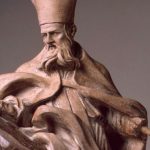“Buddenbrook-House” at Mengstraße 4, Lübeck, was largely destroyed in the March 1942 RAF raid, renovated in the late 1950s, and museumified three decades ago. What remains is a stylistic mix: ersatz Northern Renaissance below and mock-transitional Rococo up top, whitewashed and artfully backlit at night. Some authentic features were restored, but not the original room layout; ongoing remodeling will take several more years. All the Mann sesquicentennial exhibitions, including “My Time: Thomas Mann and Democracy”, thus take place in the St. Annen-Museum, about a fifteen-minute walk away.
“My Time” argues this: Thomas Mann openly converted from a chauvinistic rejection of all politics in Reflections of a Nonpolitical Man (1918) to embracing democracy as the moral solution to modern barbarism, obvious in Nazism. This story may not be familiar to general readers, and it’s clear that “Thomas Mann and Democracy” tries to justify itself to the public by squaring Mann’s thought with current events—undemocratic backsliding even in nearby places that within living memory had to struggle for freedom (Lübeck was right on the East German border). The problem, however, is that the curators make the tidy narrative literal and misunderstand Mann’s “aristocratic” ideals, which are hard to grasp given what passes for civic virtue in Germany and elsewhere.
The feel-good democratic story isn’t all wrong. The exhibition is organized around the speech “The Years of My Life” (1950), in which Mann quite rightly says that humanity can only be defended in peaceful democracies and not lying totalitarian regimes. Viewers move through rooms representing the stages of Mann’s career: the militarism of Reflections, the democratic turn in “On the German Republic” (1922), and his early denunciations of National Socialism as “a mishmash of hysteria and outmoded romanticism” and “a language of mystical moral rectitude and extravagant absurdism.” These quotations appear on the walls alongside photographic collages of ruined cities, posters announcing aid from the Marshall Plan, and the dread mushroom cloud over Nagasaki, above which is one prominent line: “From the depths of the human breast, the cry arises today: Peace, for God’s sake, peace!” This is complemented by archival footage, and some of the walls even display a specially made graphic novel depicting political scenes from Mann’s literary works.
The last is an inspired choice, giving visual force to ideas that would otherwise be very remote, especially for younger visitors. These panels actually have more meat than the wall quotes. Fans often defend graphic novels too eagerly, as if they were an inherently lesser form. In the age of social media, however, the isolated quotation—a prettied-up visual soundbite—may be doing more damage to public literacy than the worst old fears about what comic books would do to young minds. The selectiveness of the curators’ quotation choices thus threatens to undo their own good intentions.
They stress Mann’s “180 degree” turn to democracy. In this version of events, the murder of the liberal Jewish Weimar foreign minister Walther Rathenau by Freikorps terrorists in 1922, which prompted Mann to write “On the German Republic,” acts as a horrifying Damascene moment. And yes, some of Mann’s earlier claims can’t be reconciled with things he says even a few years later. In Reflections, for instance, Mann contrasts the “politicization of the intellect” (i.e., arguing for social freedoms and voting rights) with reverence of the cultured, “Germanic” soul. Eight years later, however, in “Lübeck as a Way of Life and Thought,” Mann applauds democracy’s “world-centredness,” humanitarianism, and civic education.
But there are blind spots: Mann’s basic assumptions—about both politics and the “ultimate profundity” of the German language—stayed the same. He even says as much in the very place meant to be evidence of total conversion: “On the German Republic,” he maintains, “continues the direction” of Reflections “exactly and without a break into the present,” since both come from and extol a tradition of German humanism.
Miss this and you miss Mann’s “aristocratic” ideals, vital for understanding his politics and aesthetics. The exhibition reduces them to one quote: how, before World War I, the German people were “free and unequal.” This is misleading, as Mann makes clear in the “Burgherly Nature” chapter of Reflections.
The artist must, for Mann, respond to two very different political demands: individualistic, “burgherly” cultivation of the romantic spirit in creating art, and philistine, “bourgeois” denial of life to take part in an atomized society; the latter tendency “spoils” the burgher’s “suprapolitical” libertinism by making politics—the subordination of all thought to the state—the main source of human meaning. Thus, the artist must live by what Mann calls “an aristocratic concept of justice that does not say, ‘To all the same,’ but rather ‘To each his own.’” If the utilitarian bourgeois ideal is to sacrifice the self to politics, the burgherly artist must cultivate the spiritual remainder.
This exhibition idealizes the noble Thomas Mann who not only changed his mind but had the courage to do so in public. We can all learn something from this, but it shouldn’t be at the expense of a more difficult Mann in whom “world-conscience” coexists with his ideal values for an artist: lonely, heroic moralism. This is, unfortunately, unacceptable when democracy means abandoning big personal ambitions lest you come across as selfish and make other people feel unworthy. I’ve heard this, and things like it, said less often in Germany than Austria or Denmark, but this attitude still clearly informs how the curators of this exhibition understand who they are and what it means to be a citizen of a democracy, preventing us from fully appreciating Mann the democrat.
















